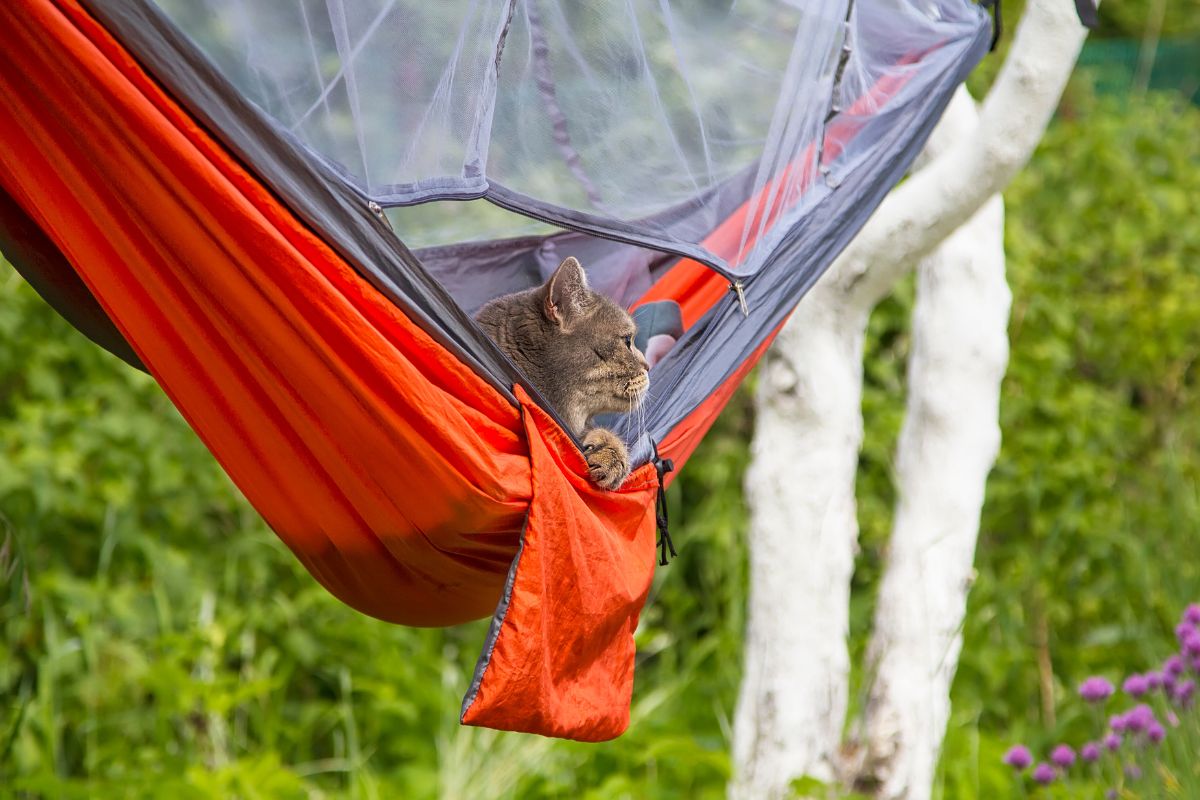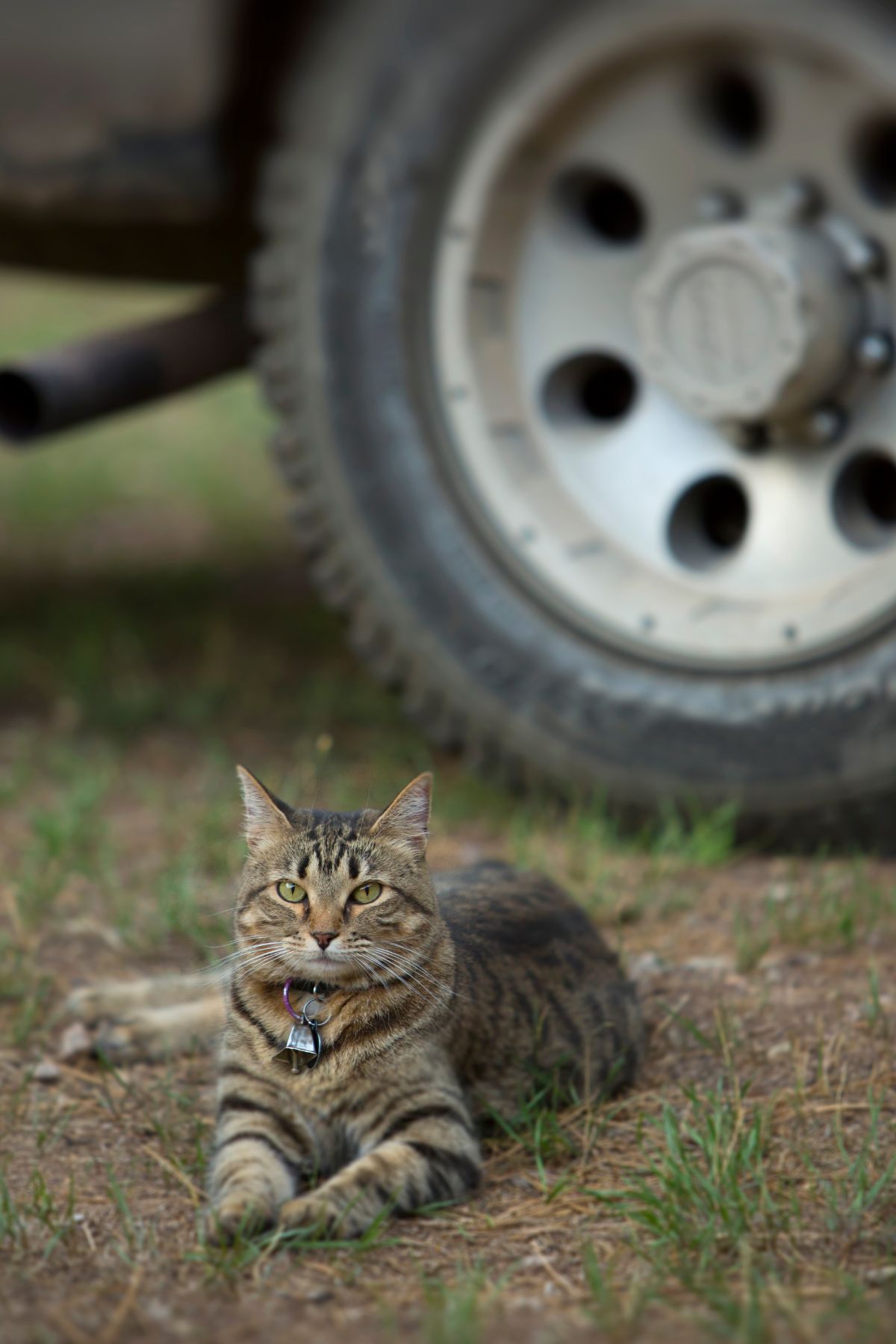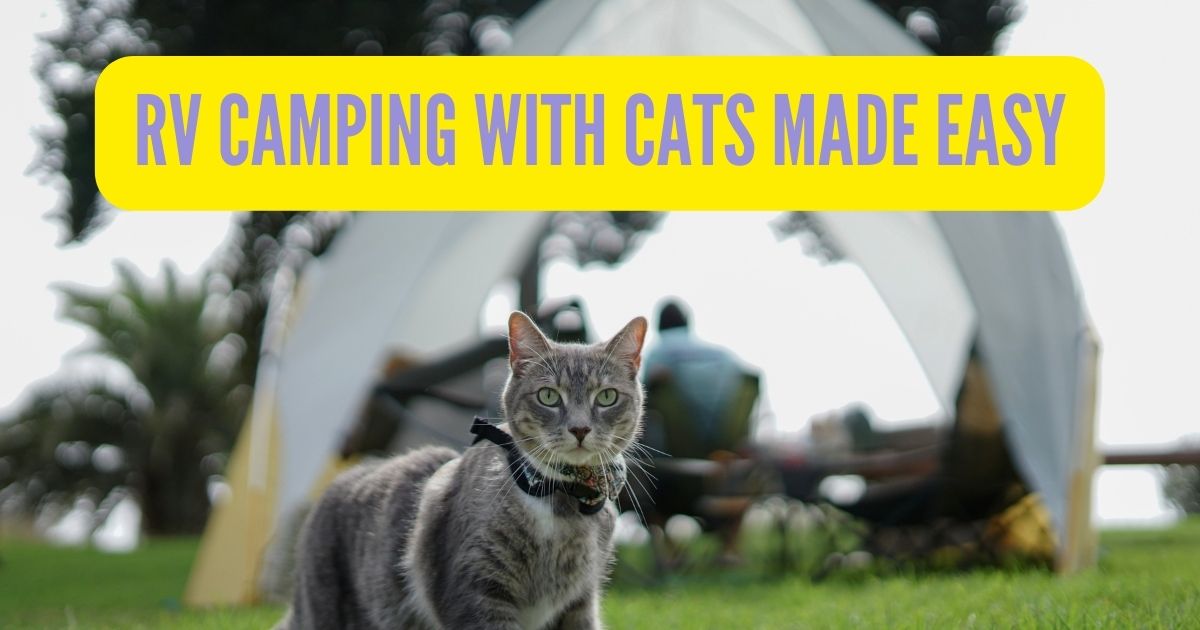Camping with a Cat-Possible or Not?
Is RV camping with cats possible? Yes, it is. However, you can’t just put a leash on your cat’s collar, pack an extra tuna can, and take your little cat into the woods. Follow this advice if you want to make sure that you and the kitten have a good time.

Questions to Ask Yourself Before RV Camping With Cats
What Kind of Trip are You Planning?
Will you stay in a trailer while driving or camping in a tent? If you have a cat that likes hiking, it is no problem. However, do not go ten miles of backpacking with your cat.
Is the Place You’re Going Pet-friendly?
Do your homework before you visit. If you’re unsure whether the place allows cats, call them ahead. Some national parks permit pets on their campgrounds and specific paths, but not in the wilderness.
All U.S. national forests allow pets; however, most of the time, they must be on leashes, and they don’t let them in swimming areas. In addition, you should know that some campgrounds will charge you more if you bring your cat. Read our article and find out Our Favorite Dog-Friendly Campgrounds in Maine.
How is the Weather?
If camping with a cat, never take it in extremely hot or cold weather. Instead, check the forecast before you and your feline companion venture outside. Before venturing out on a particularly hot or cold day, consider the length of your cat’s coat, or lack thereof. Your cat might need sunscreen if it is a breed without hair or has fine light-colored fur.
Have You Packed the Right Cat Camping Gear?
It would help if you packed all the essentials for your canine companion and outdoor gear. Don’t leave out a first aid kit, a blanket to keep your cat warm, and a collapsible water bowl.
What is Your Cat Going to Eat?
Bring enough food for each day you intend to camp and pack the same food your cat eats at home. By doing this, you will prevent any digestive problems. Bring a few extra items, just in case.
Cats require between 250 and 300 calories daily to maintain weight. Uncertain about how much to feed your cat? Speak to your veterinarian since each meal is unique. Be a nice parent and provide treats for your cat camper to enjoy when it arrives at the campsite. And sure, place your cat food in the gear bag.
How Will You Keep Your Cat Hydrated?
To keep your cat hydrated, don’t rely on your cat’s wet food. Carry plenty of water for both of you to drink. Your cat needs fresh water, but it shouldn’t be water from ponds or streams. Such water may include bacteria that can infect people. It may also have parasites like Giardia.
If you cannot drink that water, your cat shouldn’t either. So, if you don’t have access to drinkable water, bring a water filter or water-treatment drops with you.
How Do You Plan to Keep Safe?
Ensure you equip your cat’s harness and leash with lights. It will make it simple to notice should it escape. Or you could adopt the “Burma the Adventure Cat” strategy and attach a radio transmitter to your cat’s collar. Still, some LEDs and supervision ought to suffice.
Craig Armstrong, the owner of “Millie the Climbing Cat,” advised “Adventure Cats” to take LEDs to put on them at night. Keep these on all night if you have to exit in an emergency. Additionally, you should never let it outside unless you immunize your cat and treat it for fleas, ticks, and heartworms.
Also, your cat needs a collar and tags in case it gets lost. Hopefully, it never occurs, but if it does, make sure you have a recent photo of your cat on your phone to show authorities.
What About a Litter Box?
While some cats don’t mind going to the bathroom in the woods, most cats would rather have a litter box nearby. Pack a compact one that will fit inside your tent. It’s good to access one in the car if you’re going to be there for a while.
Clean it up if your cat uses the forest as its litter box. You may find Toxoplasma gondii, a protozoan parasite that may infect any warm-blooded mammal, in cat feces. T. Gondii leads to several health problems and can be particularly dangerous for expectant mothers.
Do You Need a Carrier?
When driving to your camping location, transport your cat in a carrier. It’s also good to bring a carrier to your campground. Consider a soft-sided carrier that can collapse or lie flat because you probably won’t want to carry a heavy plastic carrier on the path.
The carriers are wonderful for camping. Do you know why? Because they give your cat a cozy spot to sleep at night and a secure location to hide out. Keeping the carrier inside the tent in an emergency is a fantastic idea. However, you may prefer to keep your cat curled up in your sleeping bag with you at night.
Have You Done a Test Run?
It is good to introduce your cat to a tent in the backyard or even within your house. This applies if it has never been inside one before. Set the tent up and give your cat some time to get used to his new sleeping space.
Do You Have Toys?
Bring a familiar blanket or favorite toy with the other necessities for cats so that your cat will feel at home inside the tent.

Our Top Tips for Camping With Your Cat
Planning is essential for camping in general. But you’ll need to make additional preparations and bring some cat camping gear if you’re camping with your cat. We’ve provided some preparation ideas for camping with a cat to aid you in that process:
Verify the Campground’s Pet-friendliness
Before you go camping with a cat, the first thing you must do is make sure the campground is pet-friendly. Your best bet is to contact local campgrounds and ask about their pet laws. The campground representative might even provide some advice to make your cat camping trip successful.
It’s crucial to locate a pet-friendly camping place. However, this may have a drawback you cannot always avoid. If a campsite allows pets, other cats will also be there. Your cat could grow anxious if they aren’t used to mingling with other animals.
Help Your Cat Acclimatize Gradually
You shouldn’t force a cat who always stays indoors to go camping. It can easily lead to your cat becoming traumatized by the experience. Take time to help an indoor cat get used to outside. Bring them out and walk them around your yard to start. They will get a taste of the outdoors thanks to this before you go on a fantastic cat camping adventure.
Also, introduce your cat to a tent so they may become used to camping. Your cat will feel at ease and make the transition to camping easier.
Create a Short Camping Vacation
The shorter the trip, the better while camping with a cat. Your cat probably isn’t equipped to go on a multiday hiking trip, even though you might be. Start by spending one safe night camping alongside your cat. Your pet will benefit from shortening your camping excursion.
While camping, you shouldn’t attempt to take your cat on any lengthy hikes. These long journeys are not just exhausting. Additionally, they expose your cat to risks. You can start thinking about longer trips that span several nights after your cat can handle one night without any problems.
Be Prepared for the Weather
You should check the weather before setting up camp with your cat. Extreme weather conditions are never the right time to camp with a cat. Too hot or too cold temperatures might be hazardous for your pet.
Only camp when the weather is ideal for preventing any temperature-related issues. Your cat will be more secure and at ease, if you plan to take them camping on the weekend with good weather.
Bring Adequate Water and Food
Since there may be contaminated groundwater, you cannot compromise on food and water.
Your cat needs adequate dry and liquid food and access to enough water to stay hydrated. Ensure your cat accesses food and water whenever necessary.
Bring the food that your cat typically consumes. Your cat will already have enough novel stimulation when camping. Consequently, presenting familiar meals will help them feel more at home.
Litter Box
You ought to pack a litter box for the journey. Your cat will have a cozy spot to relieve itself. Additionally, you should keep the litter box at the same site throughout the journey. You can do this in your car or inside your tent. In either case, keeping the litter box in one location will make it simple for your cat to locate it when it’s time for a bathroom break.
Order a Leash
A leash with a harness is an excellent accessory for camping with a cat. Many of us believe that leashes belong to pets. Contrary to popular belief, cats can also use them. Cats wandering off while you’re not paying attention is one of the primary risks of camping with one. Your cat could be in danger once they are out of sight.
They might run into some wild creatures or become stranded in a tree. You must limit your cat’s access to certain areas to prevent that. Connecting your cat to a leash is the most dependable way to accomplish it. Consider fastening the leash to a tree or a picnic.
Practice Fire Safety
Fire safety is of the utmost importance whether we are discussing camping with a cat or camping in general. Negligence in this area can harm you, your cat, and the neighborhood. Although they are one of the most pleasurable features of camping, you should not wholly avoid campfires.
However, it implies that you must always watch your fire closely. Your cat may be unfamiliar with fire. And as a result, it might develop intense curiosity. Keep a watchful eye on your cat’s behavior near a fire. They could occasionally feel the need to touch the fire out of curiosity.
The best action is to keep your cat away from the fire completely. This will significantly lower the possibility of your cat suffering a severe burn.
Watch Out for Your Cat
While camping, make sure your cat is constantly within sight. You should take your cat with you if you leave your campground for whatever reason. It will be less likely for your cat to get lost if you keep a watch on them.
You don’t want to deal with a missing cat because the environment has many inherent dangers. Keep an eye on your cat during a camping trip to avoid that unpleasant outcome.
Be Ready to Look for Your Cat if it Gets Lost
Your cat could get lost even if you keep an eye on them. You should be ready to look for your cat if it occurs. As you might expect, locating a cat in the wild might be challenging. There are many locations where your pet could hide, especially in the woods. That task gets even more difficult at night.
Start by looking in any obvious places where your cat would try to hide, such as cracks in rocks or holes in trees. If your cat gets lost at night, illuminating its eyes with a flashlight can be a dependable solution. Your cat could get lost even if you keep an eye on them. Be ready to look for your cat if it occurs.
As you might expect, locating a cat in the wild might be challenging. There are many locations where your pet could hide, especially in the woods. That task gets even more difficult at night.
Start by looking in any obvious places where your cat would try to hide, such as cracks in rocks or holes in trees. If your cat gets lost at night, illuminating its eyes with a flashlight can be a dependable solution.
Cat Camping Gear You Need Before Hand
It’s better to be ready for anything while going on a trek, camping trip, or any other outdoor excursion. Always be on the lookout when taking your adventurous cat outside. Please put in mind the points listed below. You are the best person to know your cat, so bring anything else they might need, especially any meds.
First-Aid Kit
A first aid kit that can treat you and your adventurous cat is a great idea, even if you’re only going on a little nature trek. That kit should, at the very least, include bandages, tape, disinfectants, and pain relievers for the humans in your trekking group.
Before going outside, you should always check that your cat is current on flea, tick, and heartworm medicines. Also, ensure you have a tick key or tweezers, just in case.
Sun Protection
When it comes to protecting yourself from the sun, this entails using sunglasses that filter UVA and UVB light. This is in addition to sunscreen with an SPF of at least 15 that shields UVA and UVB radiation. Sunglasses are even more crucial if you plan to hike in the snow. Your cat can also require sun protection, particularly if it has light-colored fur.
Fire
Bring matches in a waterproof case or pack some waterproof ones even if you don’t intend to camp out. A chemical firestarter, dry tinder, or dryer lint are otherwise additions.
Illumination
Your night vision probably isn’t as strong as your adventurous cat. So, bring a flashlight, lantern, headlamp, or other light sources along with spare batteries. Your best option might be light because it frees up your hands to grip onto a leash or, in an emergency, a cat.
Insulation
Dress in layers and pack an extra layer in case of the weather changes quickly, especially if you’re going into the mountains. You should also include rain gear. Consider the worst weather scenarios you could encounter before leaving and pack accordingly. You might need to bring a small blanket with you to keep your cat warm as well.
Pocket-Knife or Multipurpose Tool
You can accomplish everything with a knife, screwdriver, and scissors, including opening cans and slicing bandages. Use some duct tape to secure your water bottle or trekking poles as a low-cost, multipurpose item.
ID Tags and a Collar
Your address, name, and contact information should always be on identifying tags for your cat. Several states, including Rhode Island, demand that cats always wear IDs. Before taking your pet outside, we also advise having it microchipped.
Recent Photo of Your Cat
Keep a recent cat picture on your phone or carry it with you. If you and your cat become separated, other hikers can see images of your pet. You should have a photo that one can print or photocopy for creating fliers or posters to put up nearby.
Poop Bags or Litter Box
The phrase “Leave No Trace” also applies to cat excrement. It’s best to clean up cat feces and dispose of them because they can contain dangerous parasites like T. gondii. There are numerous disposable and collapsible litter box solutions if your adventurous cat likes to utilize one.
Emergency Shelter
Even if you don’t want to stay the night, you’ll be glad you brought a tent, tarp, emergency blanket, or even a big garbage bag if you become lost or hurt. Following the directions below, you can create an emergency shelter in minutes using just a tarp and some paracord.
FAQS About Camping With Cats
Q: Are cat backpacks cruel?
A: Not all cat backpacks are cruel. Many felines find that being transported in a cat bubble backpack is enjoyable. But remember that every cat has a distinct personality. Therefore, although some cats adore being in a backpack, others are completely opposed to it.
Test-drive a cat backpack on short walks around your house before you decide to take your feline on an adventurous camping vacation. If not, perhaps think about different camping arrangements for you and your cat, like using a cat harness.
Q: Are cat tents for camping any good?
A: Contrary to common assumption, most cat tents aren’t for outdoor camping. Instead, they use them as a play area. Since tents are safe spaces, most cats prefer to spend their nights in them with their owners. Therefore, there is typically no need to camp with a separate cat tent.
Q: Where do you put the cat litter box in an RV?
A: You have several alternatives for keeping your litter box, depending on how you set up your RV. In an RV, a cabinet or storage space is one of the greatest places to keep a litter box. Doing this may prevent road messes and accidents by keeping the litter box safe and secure. Create a small access hole in the cabinet door or storage space to allow your cat to go in and out of the litter box as needed.
Afterward, all you have to do to clean the litter box is open the cabinet or storage space, scoop up the poop, and then shut the door. That’s all there is to it.

Summary
Have you ever camped with your cat? Camping with cats in a travel trailer can be challenging. Therefore, the need to prepare is essential for the health and safety of your cat. So, consider all our tips before heading out on an adventure with your cat. By now, you know how to take your cat camping. So, happy camping!
